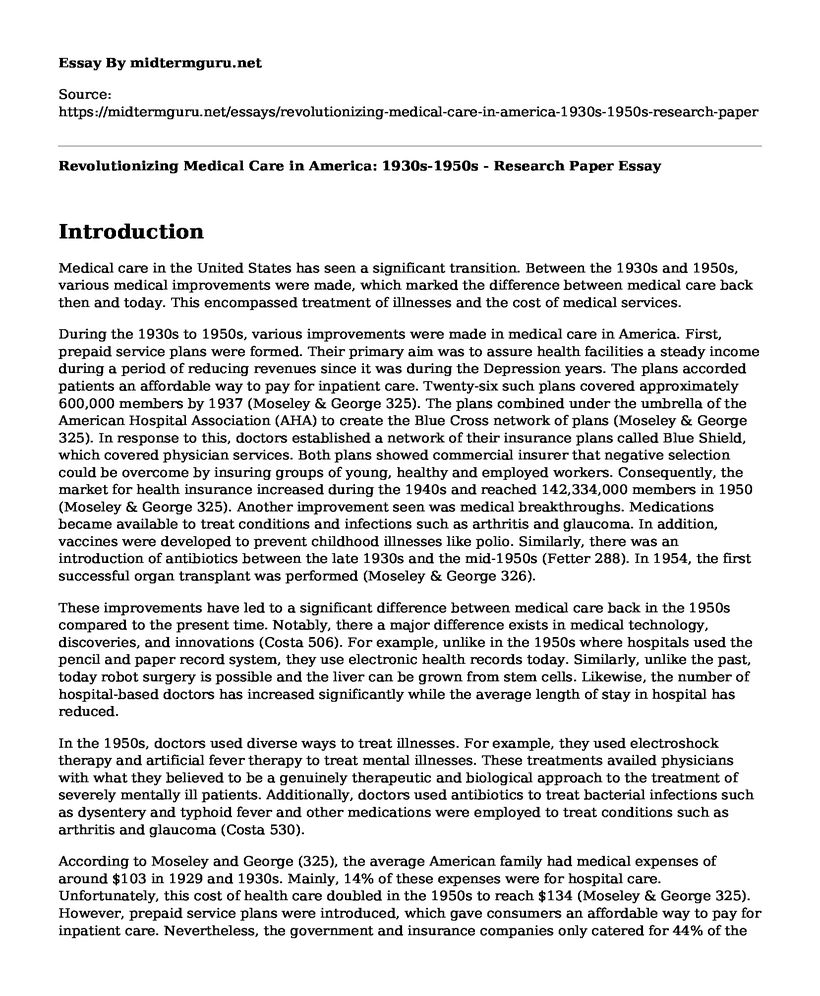Introduction
Medical care in the United States has seen a significant transition. Between the 1930s and 1950s, various medical improvements were made, which marked the difference between medical care back then and today. This encompassed treatment of illnesses and the cost of medical services.
During the 1930s to 1950s, various improvements were made in medical care in America. First, prepaid service plans were formed. Their primary aim was to assure health facilities a steady income during a period of reducing revenues since it was during the Depression years. The plans accorded patients an affordable way to pay for inpatient care. Twenty-six such plans covered approximately 600,000 members by 1937 (Moseley & George 325). The plans combined under the umbrella of the American Hospital Association (AHA) to create the Blue Cross network of plans (Moseley & George 325). In response to this, doctors established a network of their insurance plans called Blue Shield, which covered physician services. Both plans showed commercial insurer that negative selection could be overcome by insuring groups of young, healthy and employed workers. Consequently, the market for health insurance increased during the 1940s and reached 142,334,000 members in 1950 (Moseley & George 325). Another improvement seen was medical breakthroughs. Medications became available to treat conditions and infections such as arthritis and glaucoma. In addition, vaccines were developed to prevent childhood illnesses like polio. Similarly, there was an introduction of antibiotics between the late 1930s and the mid-1950s (Fetter 288). In 1954, the first successful organ transplant was performed (Moseley & George 326).
These improvements have led to a significant difference between medical care back in the 1950s compared to the present time. Notably, there a major difference exists in medical technology, discoveries, and innovations (Costa 506). For example, unlike in the 1950s where hospitals used the pencil and paper record system, they use electronic health records today. Similarly, unlike the past, today robot surgery is possible and the liver can be grown from stem cells. Likewise, the number of hospital-based doctors has increased significantly while the average length of stay in hospital has reduced.
In the 1950s, doctors used diverse ways to treat illnesses. For example, they used electroshock therapy and artificial fever therapy to treat mental illnesses. These treatments availed physicians with what they believed to be a genuinely therapeutic and biological approach to the treatment of severely mentally ill patients. Additionally, doctors used antibiotics to treat bacterial infections such as dysentery and typhoid fever and other medications were employed to treat conditions such as arthritis and glaucoma (Costa 530).
According to Moseley and George (325), the average American family had medical expenses of around $103 in 1929 and 1930s. Mainly, 14% of these expenses were for hospital care. Unfortunately, this cost of health care doubled in the 1950s to reach $134 (Moseley & George 325). However, prepaid service plans were introduced, which gave consumers an affordable way to pay for inpatient care. Nevertheless, the government and insurance companies only catered for 44% of the health care costs and people had to pay the rest out-of-pocket.
Conclusion
To conclude, it is clear that medical care in the US has undergone significant changes. Various improvements such as the use of vaccines, antibiotics and the introduction of health insurance were made during the 1930s and 1950s. Doctors used diverse treatment methods to manage different illnesses. Undeniably, medical care in the 1950s differs from that of present time regarding costs, medical technology, and treatment methods.
Work Cited
Costa, Dora L. "Health and the Economy in the United States from 1750 to the Present." Journal of economic literature 53.3 (2015): 503-70.
Fetter, Bruce. "Health Care and Social Change in the United States A Mixed System, A Mixed Blessing." Hygiea Internationalis 4.1 (2004): 277-298.
Moseley III, George B. "The US Health Care Non-System, 1908-2008." AMA Journal of Ethics 10.5 (2008): 324-331.
Cite this page
Revolutionizing Medical Care in America: 1930s-1950s - Research Paper. (2022, Dec 27). Retrieved from https://midtermguru.com/essays/revolutionizing-medical-care-in-america-1930s-1950s-research-paper
If you are the original author of this essay and no longer wish to have it published on the midtermguru.com website, please click below to request its removal:
- Essay Sample on Public Health
- Paper Example on American Red Cross Agency
- Paper Example on Psychological Benefits of Touch Bond after Birth
- Tailor-Made Solutions: Healthcare Professionals Embrace Case Management for Diabetes - Essay Sample
- Optimizing Patient Flow: IT & Process Management for Quality Care - Essay Sample
- Cancer Research: Unveiling Genetic Signatures to Treat Aggressive Tumors - Essay Sample
- Acadia Pharmaceutical: Maximizing Profit & Competitive Advantage Through Strategic Planning - Essay Sample







